Game Date: Apr 26th, 2064
Suggestions
Forum >> Suggestions >> Expanded Minor League Rosters 
 |
|  |
| 
| Post ID | Date & Time | Game Date | Function |
|---|---|---|---|
| #64672 | 04/13/2019 12:49:52 am | May 31st, 2040 | |
|
Haselrig Joined: 04/13/2014 Posts: 2790 Novi Doubledays III.4 
| As a bit of an offshoot of this suggestion, I'd like to see a change where we don't need a roster spot to draft a player. In this scenario, a drafted player wouldn't occupy a roster spot until you chose whether to sign them or not. The actual mechanic could be as simple as drafting one of your ten prospects and on his card you would see two buttons. One that reads "Sign" and one that reads "Waive". You'd have all the time between rounds to decide on whether you want to sign him or waive him. During that time, he wouldn't occupy a spot on your 50 man or participate in minor league games. Even though this would likely hurt my waiver activity as I'm one that takes advantage of those hoping-something's-there-so-I-drop-a-guy cuts, this seems like a fairer way to handle the draft/full roster problem. |
||
| #64684 | 04/13/2019 7:29:39 am | May 31st, 2040 | |
|
Seca Joined: 05/05/2014 Posts: 5201 Waterloo Dinosaurs Legends 
| Some napkin math. You can take exception to any (or all) of these numbers. They are my best guess and not real data. On average, 50 roster spots. 1 open spot to waiver draft. 12 pitchers, 16 position players, leaves 21 minor leaguers. Average career: 24 to 32 or 33. 6 or 7 seasons. With 28 players, on average replacing 3 to 3.5 players per season. Draft all HS/Latin. Average minor time 17 to 23 or 6 seasons. With 21 minor leaguers, that's 3.5 graduates per season. That is basically a steady state. This is what established teams do. Note that you can increase supply by drafting College or Asian (reducing gestation time) or by having a "lean" major league roster. This is what rebuilding teams do. The "problem" with a steady state is busts. There is little redundancy if a prospect fails. I don't really consider this a problem. A very savvy manager would recognize a high risk prospect and groom an alternative. More likely a replacement will need to be found on waivers. This represents a different skill set for the manager, and I personally feel this skill set should be necessary to make a successful team. Not super fond of full apple rosters. (Note that bust rates, especially for experienced managers, are lower in BrokenBat than most games of this ilk.) If rosters are expanded to 60, now you are carrying 30-31 minor leaguers (a 50% increase). You are now graduating 5.2 players per season on average, a clear surplus. What happens to the surplus? It hits waivers in some form. Some 24 yr that don't have a spot. Some 27-28 that aren't performing well. Some 30-31 cut for a kid. That actually sounds sorta ... good. Especially for a new team. Having a greater supply of potentially useful players in the 23 - 28 age bracket could be very helpful. These are the problems I see: - the transition When Freddy talked about this being bad for new players, he's talking about the transition. With more roster spots the number of players being released would crater (loss of liquidity). Claim inflation would sky rocket. This wouldn't be a 1 season effect. It would seasons to sort itself out. Ultimately roster size is like a cup. If you replace it with a larger cup it holds more, but eventually the larger cup overflows to. Getting to the overflow would be painful. This could be mitigated by having roster size "creep" over several seasons. Add 1 spot every 2 seasons for 5 seasons. (I think even this would be felt). - player quality With 21 roster spots for minors, "lucky" teams are sometimes forced to cut good players. You need to have pitchers and SS and OF. If you waiver/draft 4 great 1B somebody has to go so you can cover the bases. With larger rosters teams wouldn't be forced to cut those good players. So while the quantity of partially developed players would increase, the quality of available players might actually drop. This would place even more emphasis on the draft (something of a hot button topic) - planning and parity A big part of being successful in this game is planning ahead. Forecasting what your needs will be and addressing those needs before they actually become an issue. Increasing the supply and partially and fully developed players would reduce the value of planning. Along the same lines, if it is easier to fix holes that might result in a more homogenous field and more parity. I'm not sure parity is a good thing in a game like baseball that includes a significant random element in determining results. - complexity My brother is a successful electrical engineer. A couple of times he's tried to pick up BrokenBat, but he clIcks the roster page and 400 pieces of data hit him in the face. Adding another 5-10 players would be easy for established managers, but is incrementally more difficult for new ones. I don't mean to speak for Admin, but I don't think BrokenBat was intended as OotP online. PHEW! I'm not sure what vibe this post sends. I used to be fully against these suggestions. Now I can see both sides. |
||
| #64685 | 04/13/2019 7:42:45 am | May 31st, 2040 | |
|
Haselrig Joined: 04/13/2014 Posts: 2790 Novi Doubledays III.4 
| I used to be fully for expanding rosters, but have settled more towards the other end of the spectrum. The draft pick roster exemption I outlined earlier is probably as far as I'd like to see us go. I think you did an outstanding job of projecting likely impacts, Seca. I suspect there would be at least a couple none of us would anticipate. The other thing I think we've noticed lately is that as Broken Bat has become a more mature game, changing even seemingly straight forward things seems to cause some ripple effects to other parts of the game that take some effort on Steve's part to reign in. I'm trying to keep that in mind whenever some suggestion for a change pops into my head these days. |
||
| #64688 | 04/13/2019 8:06:58 am | May 31st, 2040 | |
|
Seca Joined: 05/05/2014 Posts: 5201 Waterloo Dinosaurs Legends 
| Very good point in your second paragraph. I remember reading an article one time that interviewed some World of Warcraft programmers, and they were describing the challenges of working with an old game. Your 5-years post a reminder BrokenBat has been around a little while. May be some similar challenges here. As for your suggestion, I definitely understand where it is coming from. It certainly feels bad cutting a player you like to draft a bum and end up with nothing. That said, any self respecting manager should keep a roster spot open for waiver claims. So in my view, your suggestion would have the most merit/value after waivers closes. Question. Now that the draft is shortened to 8 rounds, do we even have a draft pick after waivers closes? |
||
| #64691 | 04/13/2019 8:44:48 am | May 31st, 2040 | |
|
Haselrig Joined: 04/13/2014 Posts: 2790 Novi Doubledays III.4 
| The draft exemption wouldn't do much for me either, but I seem to see that complaint a lot. I think there are players that play large chunks of the season without placing waivers. It would be more for them than for owners who are more active on waivers. | ||
| #64704 | 04/13/2019 4:11:07 pm | Jun 2nd, 2040 | |
|
Rock777 Joined: 09/21/2014 Posts: 9599 Haverhill Halflings III.1 
| I generally agree with Seca, although in my experience, I have about a 75% bust rate. | ||
| #64713 | 04/14/2019 6:04:01 am | Jun 4th, 2040 | |
|
Seca Joined: 05/05/2014 Posts: 5201 Waterloo Dinosaurs Legends 
| Haha! Truthfully, if your bust rate is higher than average, you should probaably draft from the college pool. Shorter gestation, greater supply to compensate. After writing my essay I was chiding myself for not using college more. Greater supply is good? With an average bust rate that additional supply means decent prospects being fed back into the grid. As a selfish established team, better to use the younger pools and reap their benefits (more time to reposition, more minor league data to work from). |
||
| #64714 | 04/14/2019 7:06:40 am | Jun 4th, 2040 | |
|
Rock777 Joined: 09/21/2014 Posts: 9599 Haverhill Halflings III.1 
| I used to always draft out to College first round, but I draft late (couple hours after it opens), so I figure its more beneficial to go after the pools less drained of talent. Not that that has worked for me either |
||
| #64723 | 04/14/2019 11:41:14 am | Jun 4th, 2040 | |
|
Seca Joined: 05/05/2014 Posts: 5201 Waterloo Dinosaurs Legends 
| Hehe. Interesting how every thread eventually becomes about the draft. Your draft philosophy made me curious, so I took a look at this season's 1st round. I'd always considered myself an early bird, but I was #65 in line this season. Haverhill was #88. First 10 picks: 2 HS, 1 Col, 3 Latin, 2 Asian, 2 Intl The Latin number surprising. By the time I drafted at #65: 18 HS, 16 Col, 7 Latin, 19 Asian, 4 Intl First 15 pot from College came out at pick #63. When Haverhill drafted at #88: 29 HS, 21 Col, 11 Latin, 19 Asian, 6 Intl Average potential: 1st 10 drafted: 13.3 2nd 10 drafted: 13.4 3rd: 12.4 4th: 13.1 5th: 13.1 6th: 12.7 7th: 13.0 (Held down by Dino 9 pot 8th: 13.4 9th: 12.3 (15 pot HS hit 2 picks b/f Haverhill) Just one sample, so not worth much. |
||
| #64743 | 04/15/2019 7:37:10 am | Jun 8th, 2040 | |
|
Rock777 Joined: 09/21/2014 Posts: 9599 Haverhill Halflings III.1 
| That would explain why it isn't helping LOL | ||